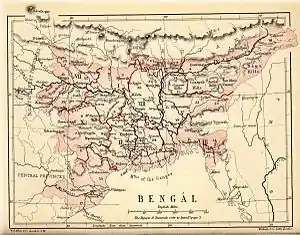| Bhavashankari | |
|---|---|
| Maharani of Bhurishrestha Raybhagini (রায়বাঘিনী) | |
 Drawing of Bhavashankari killing a bison | |
| Predecessor | Rudranarayan |
| Successor | Pratapnarayan |
| Spouse | Rudranarayan |
| Father | Dinanath Chaudhuri |
| History of Bengal |
|---|
 |
Maharani Bhavashankari (Bengali: মহারানী ভবশঙ্করী, romanized: Maharanī Bhavaśaṅkarī) was a ruler of Bhurishreshtha kingdom of Bengal, who resisted the Lohani Pathan sultans of Southern Bengal and established Hindu sovereignty in her kingdom.[1][2][3]
Early life
Bhavashankari was born in a Bengali Brahmin family as the eldest daughter of to Dinanath Chaudhuri, a Nayak. Her mother died while giving birth to her younger brother, leaving her at a young age.[4]
Coronation and the Battle of Bashuri
Bhavashankari returned to the capital early next morning and assumed control of the affairs of the State.[5] In absence of hard evidence, she couldn't try Chaturbhuj Chakravarti and instead demoted him on the pretext of security breach. Raja Bhupati Krishna Ray, the commander of the Pendo fort, was promoted to the post of Sarbadhinayak, the commander-in-chief of the armed forces. Apart from that she took immediate steps to strengthen the army in terms of numbers as well as infrastructure. She herself took the responsibility of their training.
Battle with Osman Khan
A sultan of Afghan sultanate of Gaur named Osman Khan Karrani attacked Bhurishrestha Kingdom with pathan soldiers destroying common houses and villages on the way.[6]
Maharani Bhavshankari on hearing the news rapidly marched towards the Afghan army and defeated them.[7] After that, Osman Khan fled to Kalinga by fear of his life and appeared as a fakir leaving his military career.[8]
Akbar had given the title Raybhagini to Maharani Bhavashankari by seeing her bravery on how she destroyed cruel Afghan sultanate of Gaur and also because this was a dream of Akbar also to defeat the sultanate.[9]
Relationship with Mughals
Mughal emperor Akbar, who was always wary of a Pathan resurgence in Bengal, decided to strengthen the alliance with Bhurishrestha. He sent Man Singh, the then governor of Bengal to the court of Bhurishrestha as the representative of the Mughal Empire. Man Singh arrived at Garh Bhawanipur with the Mughal seal. In a special ceremony, the charter of alliance was signed between the Kingdom of Bhurishrestha and the Mughal Empire. Through this treaty, the sovereignty of Bhurishrestha was formally accepted by the Mughal empire. The treaty required the former to send a gold coin, a goat and a blanket to the latter as a token of alliance. Maharani Bhavashankari was bestowed with the title of 'Raybaghini' and the Mughals never ever interfered with her Kingdom of Bhurshut.[10]
Legacy
Maharani Bhavashankari became famous by her title Raibaghini, who gradually came to denote a courageous or sometimes rebellious woman and became a part of Bengali proverb. Her story of valour became a part of folklore and were immortalised by ballads and village poets. In February 2012, the West Bengal government inaugurated the annual Raybaghini Rani Bhavashankari Smriti Mela to commemorate her.[11]
References
- ↑ Ghosh, Paschimbanger Sanskriti, Volume II, pp. 224
- ↑ Ghosh, Anil Chandra. বীরত্বে বাঙালী [Heroism of the Bengalis] (in Bengali) (9th ed.). Kolkata: Presidency Library. pp. 48–50.
- ↑ "Bengal's Rani Bhavashankari, called Raibaghini by Akbar was no less than Rani Lakshmibai!". Get Bengal. Archived from the original on 1 October 2022. Retrieved 7 September 2021.
- ↑ Tanima (14 September 2020). "Known Famously As "Raibaghini", This Queen Of Bengal Was No Less A Fighter Than Rani Laxmibai". lifebeyondnumbers.com. Archived from the original on 11 January 2022. Retrieved 11 January 2022.
- ↑ Sarkar, Suphal (31 July 2006). উদয়নারায়ণপুরে ধ্বংসের মুখে প্রাচীন মন্দির. Kolkata: Anandabazar Patrika. Archived from the original on 7 July 2011. Retrieved 7 August 2010.
- ↑ Congress, Indian History (1945). Proceedings - Indian History Congress. Congress publications. p. 300.
- ↑ SHARMA, PEEYUSH (11 June 2021). BRAHMAN ITIHASA: FORGOTTEN HISTORY OF BHARATVARSHA. PEEYUSH SHARMA. p. 83. ISBN 979-8-5188-2870-4.
- ↑ Datta, Saurav Ranjan. Goddesses of Fury: History's Most Daring Queens. The Little Booktique Hub. p. 160. ISBN 978-93-93209-19-1.
- ↑ Bengal (India), West (1972). West Bengal District Gazetteers: Calcutta and Howrah. State editor, West Bengal District Gazetteers. p. 81.
- ↑ Sarkar, Suphal (31 December 2008). রায়বাঘিনীর স্মৃতি পরে রয়েছে অবহেলায় (in Bengali). Kolkata: Anandabazar Patrika. Archived from the original on 20 July 2011. Retrieved 7 August 2010.
- ↑ Gangopadhyay, Ramaprasad (15 May 2012). সংস্কারের অভাবে হারাচ্ছে ইতিহাস. Anandabazar Patika (in Bengali). Kolkata. Archived from the original on 21 October 2014. Retrieved 17 October 2014.
Bibliography
- Bhattacharya, Bidhubhusan (2009). Raybaghini O Bhurishrestha Rajkahini. Kolkata: Nababharati Prakashani.
- Ray, Bharat Chandra. Raibaghini.